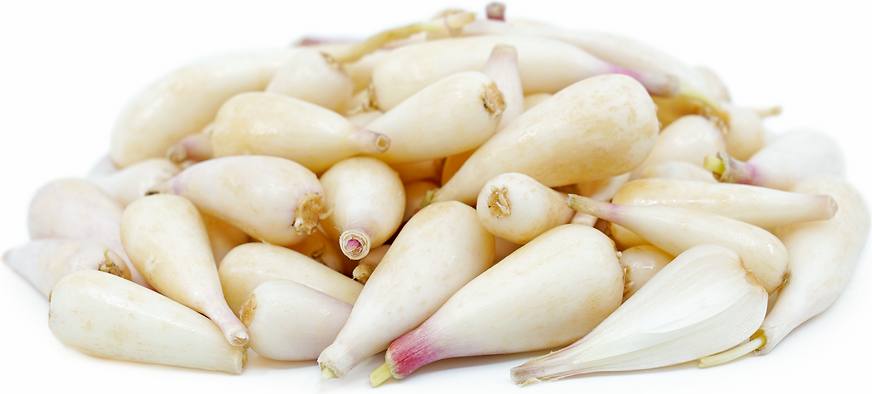


Ramp Cloves
Estimated Inventory, lb : 0
Description/Taste
Ramp cloves are the bulbous, bottom-ends of ramps or wild leeks. They grow beneath the ground, producing above ground between 2 and 3 long, thin stems topped with broad leaves tapering to a point. The tear-drop shaped cloves are between 3 and 5 centimeters long and bright to creamy white with small rootlets growing from the ends. Ramp cloves are intensely flavored, offering a strong, oniony-garlic flavor that is more concentrated than their leaves.
Seasons/Availability
Ramp cloves are available during the spring months.
Current Facts
Ramp cloves are the bright white bulbs of wild leeks. They are botanically classified as Allium tricoccum and are rare due to their limited seasonality and “just right” growing conditions. Related to onions and garlic, Ramps are sometimes referred to as Spring onions or Broadleaf Wild leeks for their characteristically wide, elongated leaves. Most Ramp cloves are obtained through foraging according to specific guidelines regarding quota to prevent over-harvesting.
Nutritional Value
Ramp cloves contain vitamins A and C and contain high amounts of vitamin B9. They are also a source of chromium, selenium, potassium and copper.
Applications
Ramp cloves may be used as a substitute for garlic or whole ramps. Use the cloves whole or minced, raw or cooked. Bake or roast the bulbs for They pair well with spring vegetables and herbs, such as chanterelle or morel mushrooms, asparagus, artichokes, peas, fava beans, and mint, seafood and poultry. Use the cloves in pastas, rice dishes and with beans. Store Ramp cloves in a bag in the refrigerator for up to 3 days.
Ethnic/Cultural Info
Popularity of the rare seasonal Ramp cloves led to regulations around the foraging of the wild leeks. The Great Smoky Mountains National Park banned ramp-foraging in 2004 to help ensure the continuation of the ramp population. Quebec, Canada classified Allium tricoccum as a threatened species and in 1995 made it illegal to sell what they call “Buchu”.
Geography/History
Ramps are native to the Mediterranean region and Appalachian Mountain region of the United States and can be found growing north into Canada. They can also be found growing in the United Kingdom, Eastern Europe, Northern Africa, the Middle East, China, South Korea, Australia, Argentina and on some of the Caribbean islands. They prefer high altitudes and low light, preferring old wood forests. Most countries have regulations in place to prevent the over-foraging of ramps and Ramp cloves specifically. Once the bulb is removed the life cycle of the plant ends. Ramps take between 5 and 7 years to produce seeds making them a challenge to cultivate due to scarcity. Foragers will harvest whole ramps and leave some of the bulbs to propagate, further limiting the availability of the bulbs. As one of the earliest greens of the spring season they are sought out by chefs and home cooks alike for their flavor and versatility. Ramp cloves may be spotted at farmer’s markets or in specialty stores.
Recipe Ideas
Recipes that include Ramp Cloves. One
| Nerds With Knives |
|
Quiche with Ramps, Bacon and Grueyere |
| Honest Food dot Net |
|
Pickled Ramps |




